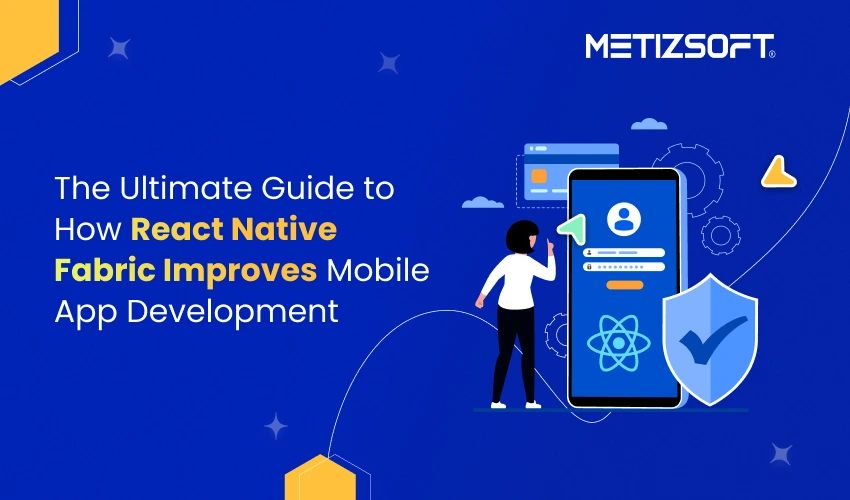
Table of Contents
Introduction
React Native has been a game-changing solution for developers and enterprises who build interactive mobile applications since 2015. However, the demand for more complex and high-performing mobile applications has evolved over the years. This led the React Native team to create a new architecture called Fabric. React Native Fabric has the potential to improve architecture and rendering processes and make React Native applications faster and more efficient.
Let’s learn more about React Native Fabric, from features to benefits. Plus, how can you use this in your next React Native project?
What is Fabric in React Native?
Fabric React Native has a significant new architecture focused on improving the interaction between JavaScript and the native layer. React Native Fabric is specifically designed to overcome the challenges of legacy systems. It renders layered systems and makes them future-proof and responsive.
Additionally, React Native’s core fabric architecture integrates more rendering logic with C++. It creates new capabilities. For React Native development, there are no platform-specific requirements, code snippets, or pointers in React Native Fabric.
React Native Fabric Features: Crucial Insights
The React Native team has introduced Fabric with several key changes to enhance performance, reduce latency, and increase the flexibility of the framework. Specifically, they have primarily focused on their core features, which can help you create new systems and improve developers’ experience.
Concurrent Rendering: One of the unique features of Fabric is support for concurrent translation. Specifically, concurrent rendering enables React to work on multiple projects simultaneously without hindering the user interface. Therefore, complex calculations or data fetching can take place in the background while the UI remains simple and functional.
JavaScript Interface (JSI): This feature allows you to interact with native code. In previous versions, React Native was handled differently. Now, the JavaScript Interface (JSI) has replaced the bridge, allowing for direct communication, reducing latency, and improving app performance.
In addition, JSI increases efficiency and speed with devices such as cameras, sensors, or GPS. It gives you great flexibility by seamlessly integrating your developer and third-party native modules.
Synchronous Layouts: Fabric has added a new way to manage layouts that work in real time. It gives developers control over how they manage settings. This makes the configuration more accurate and faster. This is indeed very useful when dealing with tricky animations or content that changes frequently.
Simplified Badge: In traditional React Native architecture, JavaScript and native code communicate via a bridge. Ultimately, this bridge can slow things down, especially in complicated apps. Fabric makes this communication simpler and faster, cutting down the delays that the bridge can cause.
Improved Gesture Handling: Handling gestures, like swipes or taps, is a key part of mobile apps. However, Fabric makes gesture handling work better by making it more compatible with standard gesture systems. Consequently, this leads to smoother and more responsive gestures, which makes the app feel better to use.
Custom Native Components: With React Native Fabric’s flexibility, you can build your own custom native components. This means you can add components directly to your React Native app, thereby giving you more control over how native views and features are displayed.
They also let you create highly customized, high-performance views for your app. The React Native Fabric architecture effectively connects native platforms with JavaScript. It ensures a smooth and consistent user experience on both Android and iOS.
TurboModule System: This feature is great for improving React Native modules. The TurboModules system helps reduce memory use and allows native modules to load only when needed. It makes communication between Native code and JavaScript smoother by using JSI. This means the app loads faster and works more efficiently without needing many native modules.
Benefits of Using React Native Fabric: An In-Depth Look
The new Fabric in React Native offers numerous benefits, such as:
Improved Performance: React Native Fabric architecture can enhance and replace the legacy bridge model using JSI. It reduces latency between native code and JavaScript. Fabric renderer React Native also has asynchronous rendering and concurrent modes. This improves UI processing by guaranteeing prioritized tasks.
C++ Compatibility: The React Native fabric architecture is built with C++ compatibility. It makes your app extremely flexible and modular. It allows your developers to write custom native components and integrate them with low-level libraries.
With C++ and Fabric, you can customize the level of communication between modules. React Native Fabric and C++ compatibility enables you to develop feature-driven, performance-driven applications, including complex information, custom animation, and modern graphics rendering.
Cross-platform Consistency: React Native Fabric also ensures that your app works the same way on both iOS and Android. You don’t have to write separate code for each platform. This saves time, reduces bugs, and lets you focus on fixing important issues. Plus, the new cross-platform system allows you to use the best performance features of each platform.
Interoperability Host Platform: One of the most important benefits of React Native Fabric is that it improves compatibility with host platforms such as Android and iOS. Fabric eliminates blockage associated with traditional bridge architectures. It also allows for more efficient access to platform-specific features like geolocation or cameras.
Type Safety: Fabric in React Native helps make your code safer and more reliable by using a modern type system. Consequently, it reduces errors that happen while the app is running and makes testing easier. Type safety makes the app more dependable and speeds up the development process. It’s especially useful for big, complicated apps. It prevents crashes or hidden bugs caused by mismatched data types.
Scalability: As applications grow in complexity, it becomes harder to maintain robust performance and responsiveness. However, Fabric’s advances in configuration management and craft controls make it easier to build scalable mobile applications that can handle complex interactions without compromising performance.
How to Get Going With React Native Fabric?
Integrate Fabric
Set up the Fabric on your next React Native project! This usually means updating your project’s build settings and selecting the right options. Here’s how you can initiate the integration:
project.ext.react = [
enableFabric: true, // Enable Fabric
]Testing and Debugging
After enabling Fabric, test your app carefully to make sure it works well. Use the helpful debugging tools and features to solve any issues.
Community Resources
The React Native community is the best option for you to learn about and initiate the Fabric adoption process. To do this, participate in community events, follow updates, collaborate with other developers, and share insights and best practices.
Hire React Native developers from a reliable resource and get started today with more efficient and streamlined execution!
Final Thoughts
Fabric in React Native is a new and improved way to make mobile app development easier. It solves many old problems and makes the system better. React Native Fabric can also boost your app’s speed, communication, growth, and adaptability. This architecture helps in creating apps for different platforms and provides great user experiences.
Whether you are a small, medium, or large enterprise, you can indeed leverage the React Native fabric architecture. Furthermore, you can create efficient and future-ready applications to tackle modern user and business requirements. Connect with a reliable React Native development company to implement Fabric’s architecture in your mobile applications.
AboutChetan Sheladiya
Related Posts
React vs. Angular- Which One Is The Ultimate Market Leader In 2021?
There are several front-end web development frameworks available in the market. Whenever someone plans to build an online app...
6 Significant Features That Every Healthcare Mobile App Must Consider
The world has witnessed an unprecedented rise in healthcare mobile apps. These apps have successfully streamlined processes...

